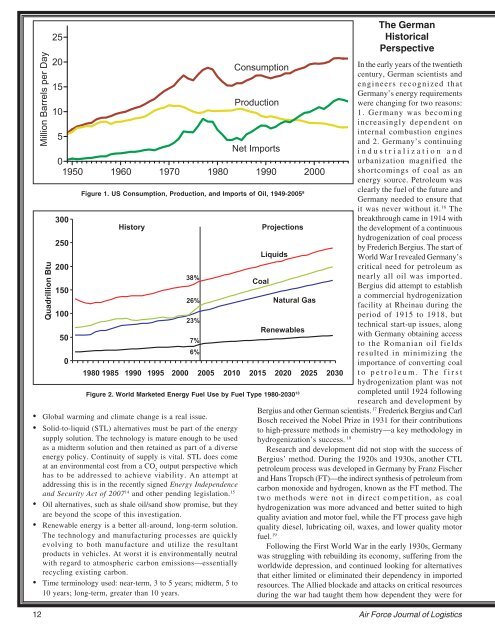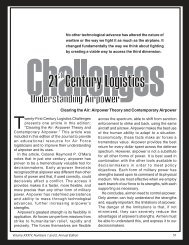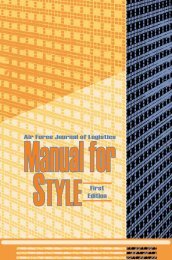Vol 32 No 4 - AF Logistics Management Agency
Vol 32 No 4 - AF Logistics Management Agency
Vol 32 No 4 - AF Logistics Management Agency
You also want an ePaper? Increase the reach of your titles
YUMPU automatically turns print PDFs into web optimized ePapers that Google loves.
Million Barrels per Day<br />
12<br />
25<br />
20<br />
Consumption<br />
15<br />
10<br />
Production<br />
5<br />
Net Imports<br />
0<br />
1950 1960 1970 1980 1990 2000<br />
300<br />
History Projections<br />
250<br />
Liquids<br />
200<br />
150<br />
38%<br />
26%<br />
Coal<br />
Natural Gas<br />
100<br />
50<br />
23%<br />
7%<br />
Renewables<br />
6%<br />
Nuclear<br />
0<br />
1980 1985 1990 1995 2000 2005 2010 2015 2020 2025 2030<br />
Global warming and climate change is a real issue.<br />
Solid-to-liquid (STL) alternatives must be part of the energy<br />
supply solution. The technology is mature enough to be used<br />
as a midterm solution and then retained as part of a diverse<br />
energy policy. Continuity of supply is vital. STL does come<br />
at an environmental cost from a CO output perspective which<br />
2<br />
has to be addressed to achieve viability. An attempt at<br />
addressing this is in the recently signed Energy Independence<br />
and Security Act of 200714 and other pending legislation. 15<br />
The German<br />
Historical<br />
Perspective<br />
In the early years of the twentieth<br />
century, German scientists and<br />
engineers recognized that<br />
Germany’s energy requirements<br />
were changing for two reasons:<br />
1. Germany was becoming<br />
increasingly dependent on<br />
internal combustion engines<br />
and 2. Germany’s continuing<br />
industrialization and<br />
urbanization magnified the<br />
shortcomings of coal as an<br />
energy source. Petroleum was<br />
clearly the fuel of the future and<br />
Germany needed to ensure that<br />
it was never without it.<br />
Oil alternatives, such as shale oil/sand show promise, but they<br />
are beyond the scope of this investigation.<br />
Renewable energy is a better all-around, long-term solution.<br />
The technology and manufacturing processes are quickly<br />
evolving to both manufacture and utilize the resultant<br />
products in vehicles. At worst it is environmentally neutral<br />
with regard to atmospheric carbon emissions—essentially<br />
recycling existing carbon.<br />
Time terminology used: near-term, 3 to 5 years; midterm, 5 to<br />
10 years; long-term, greater than 10 years.<br />
16 The<br />
breakthrough came in 1914 with<br />
the development of a continuous<br />
hydrogenization of coal process<br />
by Frederich Bergius. The start of<br />
World War I revealed Germany’s<br />
critical need for petroleum as<br />
nearly all oil was imported.<br />
Bergius did attempt to establish<br />
a commercial hydrogenization<br />
facility at Rheinau during the<br />
period of 1915 to 1918, but<br />
technical start-up issues, along<br />
with Germany obtaining access<br />
to the Romanian oil fields<br />
resulted in minimizing the<br />
importance of converting coal<br />
to petroleum. The first<br />
hydrogenization plant was not<br />
completed until 1924 following<br />
research and development by<br />
Bergius and other German scientists. 17 Frederick Bergius and Carl<br />
Bosch received the <strong>No</strong>bel Prize in 1931 for their contributions<br />
to high-pressure methods in chemistry—a key methodology in<br />
hydrogenization’s success. 18<br />
Research and development did not stop with the success of<br />
Bergius’ method. During the 1920s and 1930s, another CTL<br />
petroleum process was developed in Germany by Franz Fischer<br />
and Hans Tropsch (FT)—the indirect synthesis of petroleum from<br />
carbon monoxide and hydrogen, known as the FT method. The<br />
two methods were not in direct competition, as coal<br />
hydrogenization was more advanced and better suited to high<br />
quality aviation and motor fuel, while the FT process gave high<br />
quality diesel, lubricating oil, waxes, and lower quality motor<br />
fuel. 19<br />
Figure 1. US Consumption, Production, and Imports of Oil, 1949-2005<br />
Following the First World War in the early 1930s, Germany<br />
was struggling with rebuilding its economy, suffering from the<br />
worldwide depression, and continued looking for alternatives<br />
that either limited or eliminated their dependency in imported<br />
resources. The Allied blockade and attacks on critical resources<br />
during the war had taught them how dependent they were for<br />
8<br />
Figure 2. World Marketed Energy Fuel Use by Fuel Type 1980-203013 Quadrillion Btu<br />
Air Force Journal of <strong>Logistics</strong>





